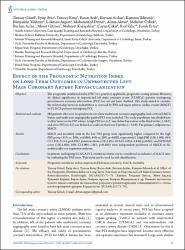| dc.contributor.author | Güzel, Tuncay | |
| dc.contributor.author | Avcı, Eyüp | |
| dc.contributor.author | Kiris, Tuncay | |
| dc.contributor.author | Arık, Baran | |
| dc.contributor.author | Arslan, Bayram | |
| dc.contributor.author | İldırımlı, Kamran | |
| dc.contributor.author | Yıldırım, Bünyamin | |
| dc.contributor.author | Argun, Lokman | |
| dc.contributor.author | Demir, Muhammed | |
| dc.date.accessioned | 2024-08-28T06:20:41Z | |
| dc.date.available | 2024-08-28T06:20:41Z | |
| dc.date.issued | 2023 | en_US |
| dc.identifier.issn | 0022-9040 | |
| dc.identifier.uri | https://doi.org/10.18087/cardio.2023.11.n2367 | |
| dc.identifier.uri | https://hdl.handle.net/20.500.12462/15073 | |
| dc.description | Avcı, Eyüp (Balikesir Author) | en_US |
| dc.description.abstract | Objective The prognostic nutritional index (PNI) is a practical, applicable, prognostic scoring system. However,
its clinical significance in unprotected left main coronary artery (ULMCA) patients undergoing
percutaneous coronary intervention (PCI) has not yet been clarified. This study aimed to examine
the relationship between malnutrition as assessed by PNI and major adverse cardiac events (MACE)
in ULMCA patients undergoing PCI.
Material and methods 185 patients who were hospitalized in our clinic underwent coronary angiography, had a critical LMCA
lesion, and underwent angiography-guided PCI were included. The study population was divided into
tertiles based on the PNI values. A high PNI (n=142) was defined as a value in the third tertile (≥ 34.0),
and a low PNI (n=43) was defined as a value in the lower 2 tertiles (< 34.0). The primary endpoint was
MACE.
Results MACE and mortality rates in the low PNI group were significantly higher compared to the high
PNI group (51% vs. 30%, p=0.009; 44% vs. 20%, p=0.002, respectively). High PNI (HR:1.902; 95%
CI:1.112–3.254; p=0.019), previous stroke (HR:3.025; 95% CI:1.038–8.810; p=0.042) and SYNTAX
score (HR:1.028; 95% CI:1.004–1.057, p=0.023) were independent predictors of MACE in the
multivariable cox regression analyzes.
Conclusions In patients undergoing ULMCA PCI, nutritional status can be considered an indicator of MACE rates
by evaluating the PNI score. This index can be used for risk classification. | en_US |
| dc.language.iso | eng | en_US |
| dc.publisher | Russian Heart Failure Soc | en_US |
| dc.relation.isversionof | 10.18087/cardio.2023.11.n2367 | en_US |
| dc.rights | info:eu-repo/semantics/embargoedAccess | en_US |
| dc.subject | Prognostic Nutritional Index | en_US |
| dc.subject | Unprotected Left Main Coronary | en_US |
| dc.subject | MACE | en_US |
| dc.subject | Mortality | en_US |
| dc.title | Effect of the prognostic nutrition index on long-term outcomes in unprotected left main coronary artery revascularization | en_US |
| dc.type | letter | en_US |
| dc.relation.journal | Kardiologiya | en_US |
| dc.contributor.department | Tıp Fakültesi | en_US |
| dc.contributor.authorID | 0000-0002-7790-8450 | en_US |
| dc.contributor.authorID | 0000-0001-9793-718X | en_US |
| dc.contributor.authorID | 0000-0003-2984-9094 | en_US |
| dc.contributor.authorID | 0000-0001-8470-1928 | en_US |
| dc.contributor.authorID | 0000-0002-9049-7123 | en_US |
| dc.identifier.volume | 63 | en_US |
| dc.identifier.issue | 11 | en_US |
| dc.identifier.startpage | 1 | en_US |
| dc.identifier.endpage | 7 | en_US |
| dc.relation.publicationcategory | Makale - Uluslararası Hakemli Dergi - Kurum Öğretim Elemanı | en_US |


















